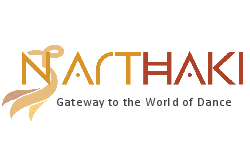
|   |

|   |
Śarṅgadeva Prasang held in Goa - Manjari Sinha e-mail: manjari@sinha.com Photos courtesy: VRPP department Goa University April 2, 2025 Mahagami Gurukul, Aurangabad, dedicated to Art, Culture and Indic Studies, has been working towards a synergy between Shastra (theory), Prayog (praxis), Parampara (traditional legacy) and Anusandhan (research) for decades. Śarṅgadeva Samaroh has been their flagship festival, with offerings ranging from seminars to research presentations, concerts and workshops, with Śarṅgadeva's Sangeet Ratnakar as their focal point for all these offerings. Śarṅgadeva for the first time, defined 'Sangeet' (music) as the combination of vocal, instrumental and dance in his Sangeet Ratnakar, "Geetam Vaadyam tatha Nrityam, Trayam Sangeetam Uchyate." The 13th century treatise Sangeet Ratnakar has been the definitive text for both, the Hindustani and Carnatic systems of Indian classical music to date. A day-long 'Śarṅgadeva Prasang' comprising a seminar, workshop and performances was held at the Directorate of Art & Culture, Panjim, Goa, on the 19th of March 2025, in continuation of the 16th edition of Śarṅgadeva Samaroh held from 17th to 20th January at the Mahagami Gurukul, Aurangabad. This important event was jointly organised by the Directorate of Visiting Research Professor Program (VRPP), Goa University and the Mahagami Art Research Foundation, Aurangabad. Guru Parwati Dutta, who holds the prestigious Nana Shirgaonkar Chair for Indian Music at the Goa University, conceptualized this event. Her researched revival of the Dhrupadangi approach to classical dance and music is being offered as an academic course at the VRPP, Goa University. Her contributions and visionary leadership in academics are a source of inspiration for the next generation of young scholars here for three consecutive years. Art lovers, artistes, students and research scholars were invited to this immersive event conducted under the Nana Shirgaonkar Chair for Indian Music, at Sanskriti Bhavan Sabhagar, Directorate of Art and Culture, Panjim, Goa. The day-long event commenced with an auspicious beginning with Ganesh Vandana, presented by Varada Bedekar and her students of Nana Shirgaonkar Chair VRPP, Goa University. This invocatory Ganesh Vandana was written and composed by Guru Rohini Bhate and choreographed by Parwati Dutta, who also taught it during the workshop. 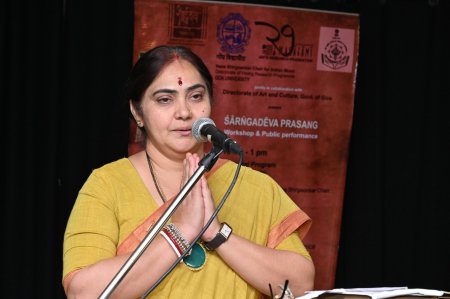 Dr. Karuna Vijayendra The Śarṅgadeva Prasang continued with the research paper presentations related to Śarṅgadeva's Sangeet Ratnakar. The well-known dance historian Dr. Karuna Vijayendra presented her research paper on the 'Aangika Abhinaya of Sangeet Ratnakar: A Desi Exploration & Sculptural Study'. Karuna Vijayendra has been Chair and Head of the Department of Bharatanatyam, Aria University, California, and is presently the Dean, Division of Yoga & Humanities at S-VYASA Deemed University, Bangalore. Opening her PowerPoint presentation with the dance sculptures in temples, she talked about the history of dance from pre-historic, historic, ancient, and medieval to the current study of dance sculptures. She focused on post-Bharata to Desi sculptures of 10th century onwards. She also deliberated upon the river-based geographical forms of Desi Loka-Kala and post-Desi 17th century onwards development of Adavu patterns and Kacheri-assisted dance called Sadir, which was later named Bharatanatyam, as a classical dance form in the 20th century. Karuna referred to the Badami and Aihole temples for reference. 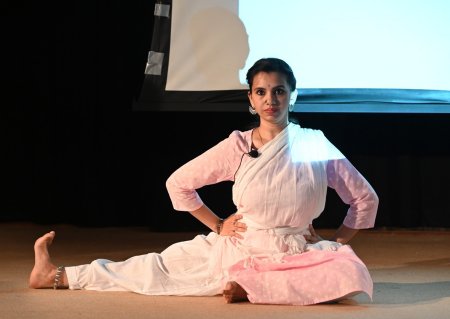 Samanvita Janardan Then she talked about the four kinds of abhinayas - Aangik, Vachik, Aharya and Saatvik - and Karanas with Hasta-Pada Sanyog. The major limbs, minor limbs that were part of Mukhaja Abhinaya, Samyukta and Asamyukta Hastas, the Bhumi and Aakash Chari and the 108 Karanas of Bharata where Śarṅgadeva added the Utpatti Karanas were all elaborated upon. Karuna had Samanvita Janardan, a student of Dr. Padma Subrahmanyam, to demonstrate the Karanas like the Talapushpa Karana decoding Charis and its different variations. Karuna also talked about different Sthanakas for male and female dancers. She gave an analogy of 'Rechaka' in dance to the 'Gamaka' in vocal and instrumental music. Samanvita demonstrated all the Karanas while singing their descriptions. The Kati Rechaka looked graceful, which could have felt stiff without the Rechaka. Karuna explained, "You have to feel and then move your nerve's energy flowing through the limbs; that is the beauty of Rechakas." She then proceeded to the Shiro Bhedas and the Greeva Bhedas, Bhramari, and Angaharas, which are combinations of Karanas. She mentioned that it was Dr. Padma Subrahmanyam's research work in the 1960s which established all this authentically. 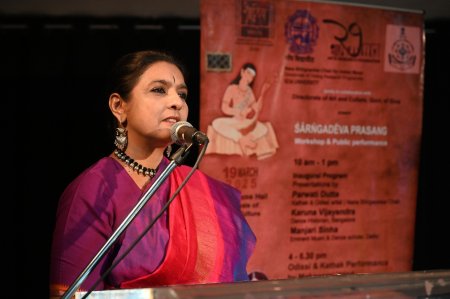 Parwati Dutta Parwati Dutta presented her paper on Lasyanga and Gharghara in Śarṅgadeva's Sangeet Ratnakar, practised in Kathak and Odissi techniques. She explained that just as Bharata thought of 'Uparupaka', Śarṅgadeva thought of the regional or Desi forms of dance as the lived experience. Natya Shastra defined Nartana as a combination of nritta, nritya and natya. Śarṅgadeva added regional extension of Desi in the Nartana adhyaya of his Sangeet Ratnakar and used the word 'nrityam' for dance. Coming to Lasyanga and Gharghara, she stated, "Lasyanga are the graceful movements of the entire body or a combination of movements of some parts of the body." She first focused on its structural part and then explored how the beauty of total dance could be enhanced with Lasyanga. She referred to the 20th chapter of Natya Shastra, where we get the elaborate description of Lasyanga, whereas Sangeet Ratnakar talks about the Desi Lasyangas. She also quoted other later treaties like the Sangeet Samayasara, Nritya Ratnakosha, Radha Govindasara, Sangeet Chintamani and the Nritta Ratnavali, which talk about the Lasyangas. "The Abhinaya Darpana is about the abhinaya part of the dance", she stated and then explained that whenever one learns to dance, the technique is taught first. The sequence is Vidya, Kala, Shilpa and Sadhana. Shilpa or technique is taught; Kala or Art cannot be taught. It is an assimilation of learning and insight. Sadhana is practice with contemplation. Whatever is written in the Shastra should be taken with insight, she remarked. Parwati explained the ten Lasyangas described in Sangeet Ratnakar. The definition of Chali she quoted, "Komalam savilaasam cha madhuram taal samyutam, Naatidrutam naatimandam tryashyata prachuram tatha." She talked about Chaalivad, Ladhi and Suka. Citing a shloka from Sangeet Ratnakar, she explained the Greeva Sanchalan that enhances the shobha or beauty by delicately shaking the ornaments worn in the ears. Urongana and Dhasak were other Lasyangas. She also talked about the Angahara, Oyarka, and smile of Shringara Rasa, which is different from the normal smile concluding with Vihasi and Mana. Talking about the 'Gharghara', she said that Gharghara is the ghunghroo or ankle bells, which were also referred to as Nupur, Kinkini, Ghantika and Ratnajalaka. Gharghara is also mentioned as an instrument in Sangeet Ratnakar. She concluded with, "We should continue enriching ourselves with this Gyana Sampada, the wealth of knowledge." This critic / musicologist was invited to deliberate upon the 'Musical Vision and Concepts in Sangeet Ratnakar.' 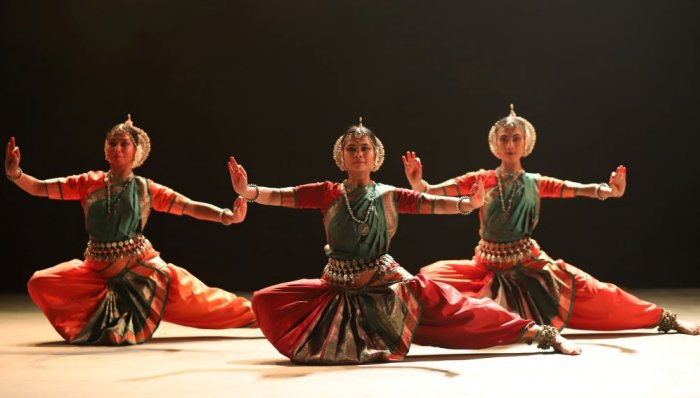 Mahagami ensemble in Odissi style The performance session opened with a Sant Jnaneshwara Pada "Chandra dethe chandrika, Shambhu dethe ambika" sung in Dhupad style by Shaunak Abhisheki. Composed in the Ovi Chhand, so typical of Marathi Abhang, it was beautifully choreographed by Parwati Dutta in Odissi style and performed by the well-trained dancers of the Mahagami Gurukul. The next performance was the 'Dhrupadangi Kathak' performance based on the in-depth research by Parwati Dutta on the Dhrupad-based music and dance, which has also been started as an academic course by the Nana Shirgaonkar Chair of Indian Music at the Goa University. Parwati had also conducted the Drupadangi Kathak workshop here, which was attended by enthusiastic students. She explained that singing a Dhrupad bandish is altogether a different thing as compared to the 'Anga Vinyas', the body movements of dance on a Dhrupad. The Dhrupad "Tero bala prataap" written and composed by Tansen in Sool Tala, was sung by Pt. Uday Bhawalkar and presented in Dhrupadangi Kathak style by the students of Parwati Dutta. 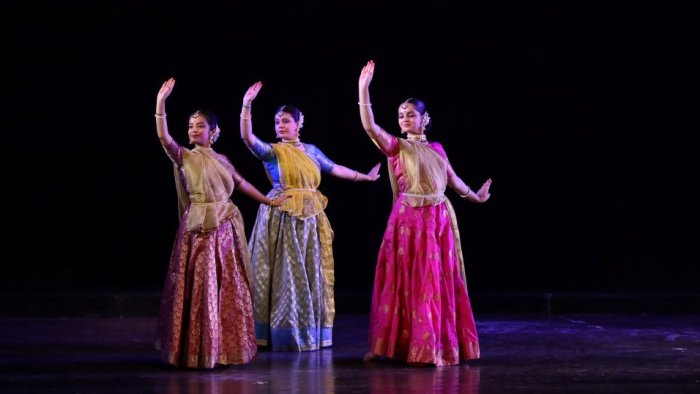 Mahagami ensemble in Kathak style Next came 'Mudita', which is one of the four laws in Buddhism, the law of eternal joy, which believes that the whole cosmos is 'Aanandamaya', blissful; it is we who keep shifting between joy and sorrow. We could stay in eternal joy with the Mudita Sadhana. This was expressed through a Pallavi in raga Madhamad Sarang set to Khemta Taal. Like the Lakshana Geet, there are compositions on Taal Lakshan also. One such composition was written and composed by Pt. Birju Maharaj about Jhap Taal and given to Parwati to present the way she wanted. The composition went "Taal Jhapatala varan karo mana bhaye", choreographed imaginatively by Parwati, where the Tali and Khali were shown as they are recited with clapping both hands and showing 'Khali' by just moving one hand. The performance session concluded with "Taarini', presented as the Dhrupadangi piece in Odissi. Taarini or Tara is one of the Dasha Mahavidyas, which is also worshipped in Buddhist tradition. It was choreographed by Parwati Dutta using the Sama Bhanga standing and sitting postures, Abhanga with body weight on one side, Tribhanga the three-fold pose with weight divided on Vaksha torso, and Kati, the waist and Ati Bhanga. Tarini is also worshipped in Shakta and Tantra traditions, mentioned in treaties and Shila Lekh, the stone inscriptions, and depicted in the Thanka paintings of Buddhist tradition. The meditative piece was based on the Dhrupad Ang Aalap in Goojari Todi progressing from the slow to medium and fast tempos concluding with Mantras like "Humm Thumm..." The standing ovation by the audiences vouched for the high standards of the day-long program comprising the in-depth research paper presentations and the captivating dance performances at the Śarṅgadeva Prasang. Sagun Velip, Director of Art & Culture, Panjim, joined the performance session. The Prasang closed with a thanksgiving by Prakash S. Perienkar, Director VRPP, Goa University. 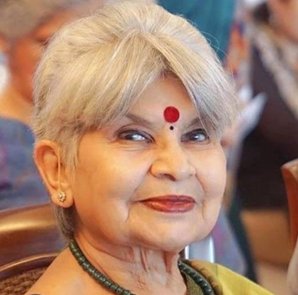 Manjari Sinha is a musicologist and an acclaimed classical music and dance critic. She has an MA in Sanskrit from Allahabad University, MA in Music from Vikram University, Ujjain; Sangeet Prabhakar in Hindustani Vocal, Tabla, Sitar and Kathak dance from Prayag Sangeet Samiti, Allahabad; and further training in Sitar under Guru Pt. Arvind Parikh in the lineage of Ustad Vilayat Khan. She has authored a book on Ustad Bade Ghulam Ali Khan, commissioned & published by Roli Books. She has contributed the chapter on Kathak for 'Indian Dance: the Ultimate Metaphor'. Her articles in English and Hindi on Music, Dance, Art & Culture are regularly showcased in a variety of leading journals and periodicals. |